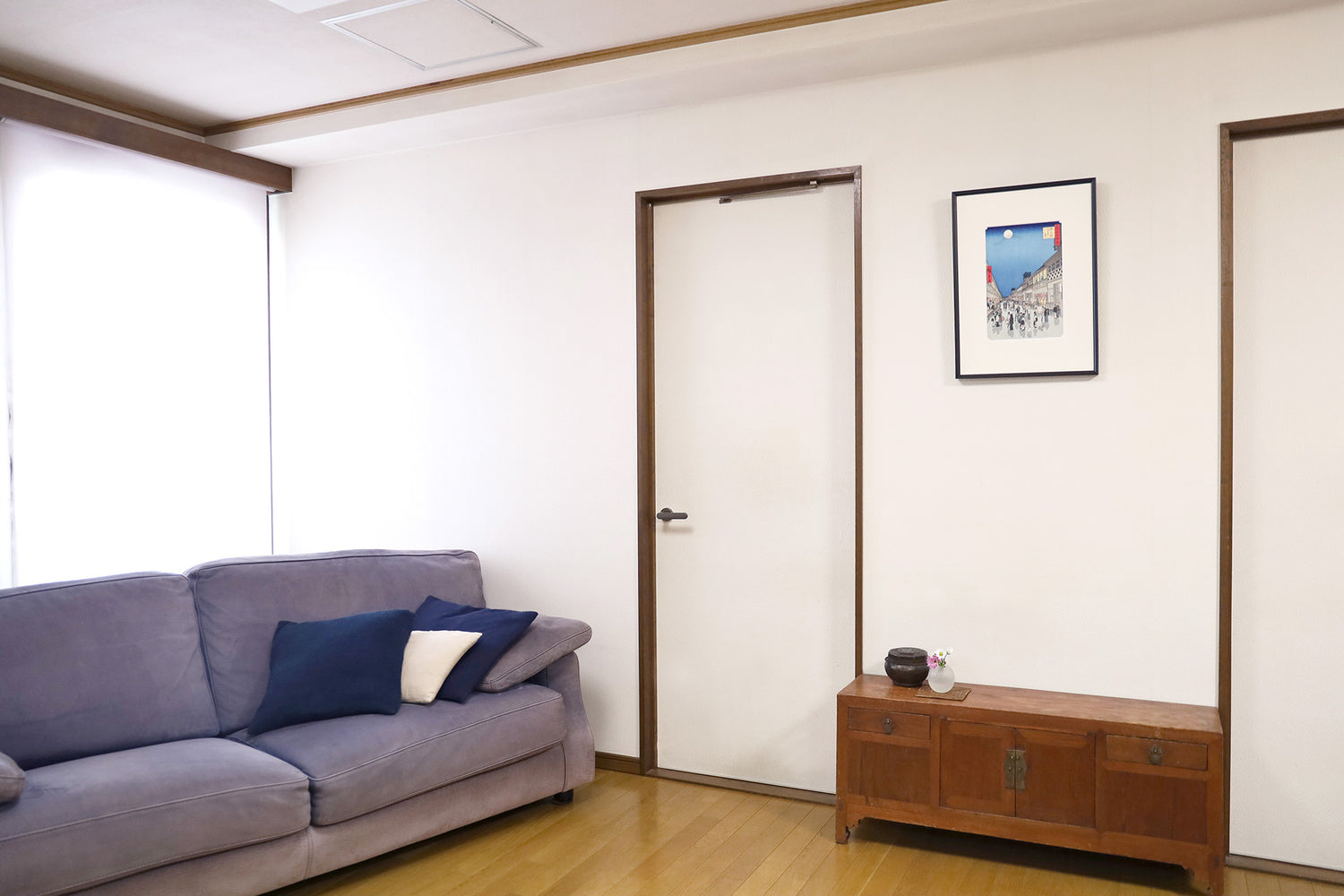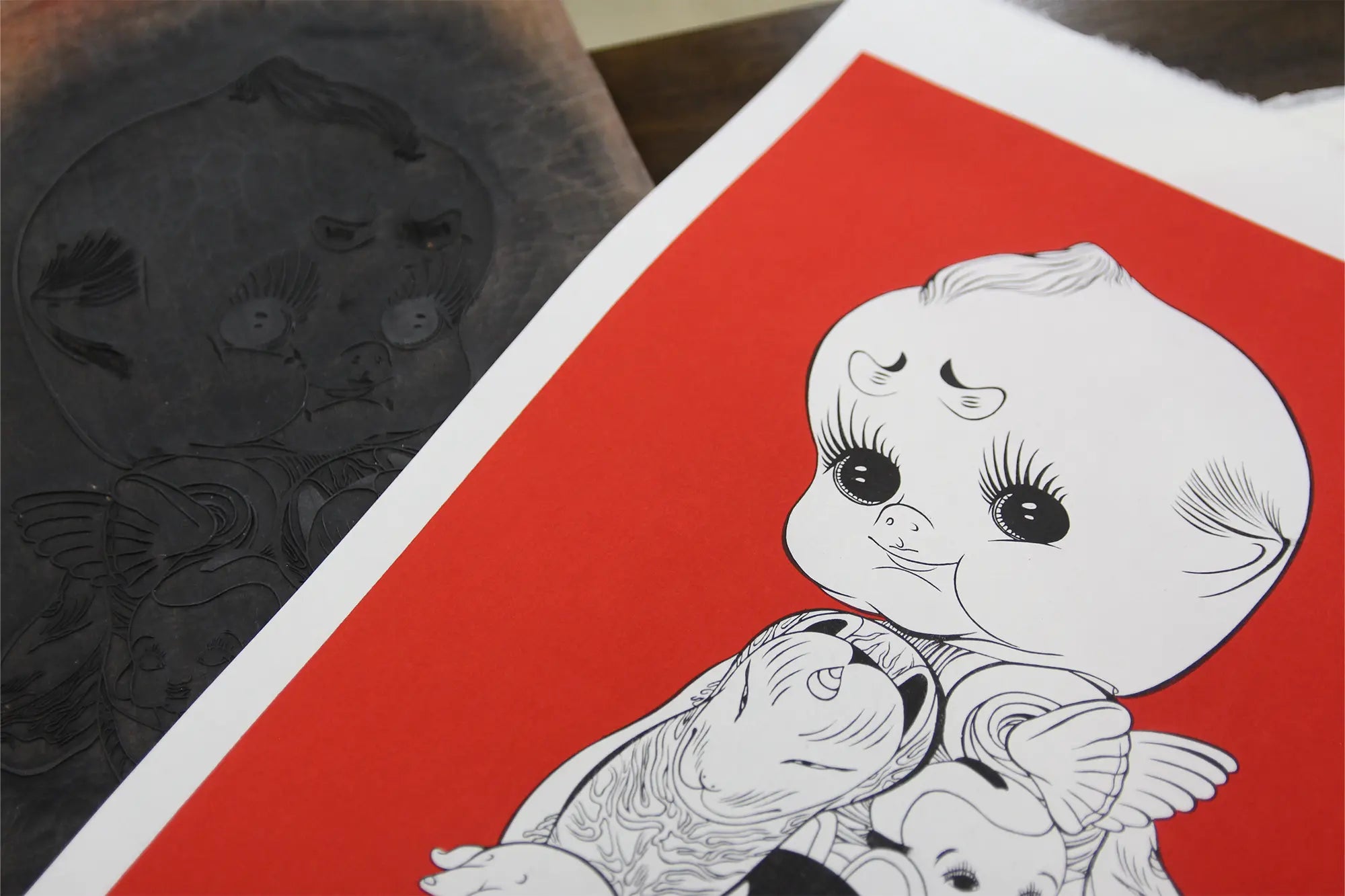
Adachi's Ukiyo-e: Enjoy displaying your art Customer interviews - Living with Ukiyo-e - "Enjoy your time at home, a window to another world"
In "Customer Interviews: Living with Ukiyo-e," we ask customers how they enjoy Adachi's ukiyo-e in their own homes.
The second person we spoke to was Omata Shoko, a writer living in Kanagawa Prefecture. Omata purchased her first Adachi ukiyo-e at the exit sales of the ukiyo-e exhibition "THE UKIYO-E 2020" held at the Tokyo Metropolitan Art Museum in the fall of 2020. A staff member at Adachi saw her Instagram post, in which she wrote about her impressions of the purchase along with a photo of Hiroshige's "Saruwakacho Night View" that she had purchased, which led to this interview.

Omata says he enjoys being exposed to Japanese culture and the techniques of artisans. What does he enjoy about Adachi Woodblock Prints' ukiyo-e reproductions? We had a long talk with him.
 This time we interviewed Ms. Shoko Omata
[Omata Shoko] In addition to planning and directing content on themes such as food, clothing, shelter, and Japanese culture, Omata Shoko writes articles for the introductory magazine to Japanese culture, "Waraku Web (Shogakukan)," as well as media outlets related to crafts and manufacturing at Nakagawa Masashichi Shoten.
|
He was born on Awaji Island, so we had a great time talking about the island with staff member Adachi, who is an island lover!
Enjoy the scenery depicted in Ukiyo-e art, "like looking at the view from a window"
-Which part of your home are you currently displaying your works in?
Omata: "My house is a multi-family home, and I live with my parents and other relatives, but I display it in the living room (western-style room) of my parents' house, where the whole family gathers. Initially, I was thinking of displaying it on the floor where my husband and I live, but after considering the size of the wall and the balance with the interior, I decided on the current location."

-You've been displaying contemporary art up until now, but were you hesitant to hang ukiyo-e prints in a Western-style room?
Omata: "I was able to display them without worrying too much. For example, if they had been large paintings or frames that limited the interior space they could be paired with, it might have been different, but I felt that they strangely blended in wherever I placed them . I had previously had the opportunity to learn that ukiyo-e was something that common people in the Edo period enjoyed on a daily basis, and I recognized that it was a kind of product design, so I feel like I was able to take on the challenge without feeling nervous, in a good way .
When I actually displayed a framed ukiyo-e, the mat (a piece of cardboard inserted between the work and the acrylic panel of the frame) cut to fit the painting acted like a window frame, and I felt as if the scenery in the ukiyo-e existed on the other side of the wall. It was as if I was peering into another world.... A window had been created that invited me into another world! That's the image I had. That's why it probably didn't feel strange to display it in a Western-style room."
--You have a really wonderful sensibility. What's beyond the window...it's an eye-opener!
Ukiyo-e prints vary slightly in size and frame even within the same series. At Adachi Prints, we cut the mats to fit the size of each piece perfectly. The slight depth created within the frame enhances the beauty of the work.
I'm happy that with this reprint, I can enjoy ukiyo-e from the same perspective as people in the Edo period.
-Have you known about Adachi woodblock prints before purchasing their works?
Omata: "Yes. Through my work, I had the opportunity to speak to people knowledgeable about ukiyo-e and read articles about them, and that's when I learned about Adachi Woodblock Prints. Until recently, I didn't know much about this world, but I was overwhelmed by the historical background and techniques. It's a world that is supported by the skills of many craftsmen , including the artists who draw the original pictures. I'm also very interested in how these techniques have been passed down to the present day."

--Thank you! What was your impression when you actually saw the Adachi woodblock prints?
Omata: "When I looked at the 'Sarwaka Town Night View' that I bought, I felt as if I was being drawn into the work, and it really drew me in. And when I realized that this wasn't painted, but printed by a craftsman, I was overwhelmed by the skill. Above all, because it is produced with the same techniques as in the Edo period, I felt like I was able to enjoy the ukiyo-e from the same perspective as the people of that time, and that made me very happy ."

A work that reminds me of the excitement and thrill I felt on my way home after seeing a play.
We continue to talk about "Sarwaka Town Night View," which inspired him to purchase Adachi's ukiyo-e.
- Regarding "Sarwaka Town Night View," what made you fall in love with the work and what made you decide to purchase it?
Omata: "I've always liked moonlit night motifs, and I fell in love at first sight with how beautiful it was. Also, the content of the painting is just wonderful. It depicts a nighttime view of a town lined with theaters, and I felt a strong connection to the world of the painting, as it seemed to link with the feelings I have when strolling home after seeing a show, immersed in the excitement and afterglow of the show and thinking, "I don't want to go home yet ."

When I was able to touch the real thing in the store, the beauty of the prints I saw in person and the emotional impact of the theme made me instinctively think, "I want to take this one home with me right away!" That was the deciding factor. (Laughs) And now, in these days when we can't go out as much as we'd like, the sparkling bustle in the work reminds me of the feelings I had on my way home after seeing the play, so I thought that was great.
-Indeed, I love going to the theater too, so I can really understand the excitement you get when you see this play.
Omata: "That's right! When my sister saw this piece, she said, 'I've been at home a lot because of the coronavirus pandemic, but when I see this painting, I can think about the outside world, and it's kind of nice.' We both had a great time seeing this ukiyo-e.
Ukiyo-e prints depict familiar seasonal flowers and landscapes, witty motifs, and scenes of people's daily lives. Perhaps it is in these times that we can find more enjoyment in the scenery depicted in ukiyo-e than ever before.
Sympathy for "Zashiki Hakkei," which tells the story of finding enjoyment in the home
Omata-san: "Actually, I recently replaced the 'Sarwaka Town Night View' with another piece that I purchased at the same time."
Saying this, he showed me Suzuki Harunobu's "Kotoji no Rakugan," which is currently on display.

"Kotoji's Rakugan" is one of the paintings in the "Zashiki Hakkei" series, which likens everyday life to scenic landscapes, following the theme of the traditional Chinese landscape painting "Shosho Hakkei." The koto is depicted as an autumn evening scene with geese flying.

"I found that witty use of language like that very interesting," said Omata, who purchased the painting. There was also a reason for the decision to change the hangings at this time.
Omata: " I felt that the idea of enjoying the scenery of the four seasons using things found in the home was very contemporary . So I took the opportunity to change the curtains."
As Omata-san said, the subject of this work seems to be in line with our current state of mind, where we are very interested in making the most of our "home time". Rather than just matching it to the season or a place associated with it, we empathize with the subject of the work and hang up the ukiyo-e. The staff were reminded of the diversity of ways to enjoy ukiyo-e.
Displaying them will make you feel closer to ukiyo-e
-Finally, please tell us what you like about displaying Adachi's ukiyo-e prints, and what changes you have noticed.
Omata: "By actually displaying them, I feel like I have become closer to ukiyo-e. Before, when I heard of ukiyo-e, I thought of it as something that appeared in history, something far away. But by displaying them in my home, they have become a part of my daily life . I was happy to realize that they are something much closer to me, something that we can enjoy today just as much as people in the past did .

Recently, even though there have been TV programs about ukiyo-e, they have made me feel very close to them, and I have become more interested in Edo period culture than ever before, and I want to learn more about it!
From start to finish, Omata-san was cheerful as he talked about the joy of learning about ukiyo-e. I was very happy to learn that after purchasing Adachi's ukiyo-e, he has become even more interested in and enjoys ukiyo-e, which he has always loved, even down to the background of the works. Thank you very much for your cooperation in this interview.

